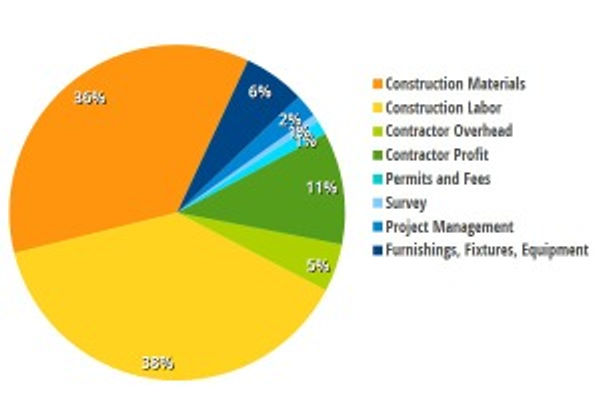
Project Budget for a typical residence. Hard costs are those directly accruing to the construction and include materials, labor, overhead and profit. Soft costs are typically defined as professional fees (in this pie chart shown as “survey” and “project management”) plus regulatory fees (shown as “permits and fees).
A project budget is made up of two parts, namely so-called “hard costs” and “soft costs” The hard cost is that related to the actual physical construction, the cost building construction itself. This fraction of the project budget is also called the construction budget.
Overall, your hard costs will include all the tangible, physical parts including not only the building itself but also those parts related to it including the building’s infrastructure plus site improvements including landscaping. By way of example, a kitchen remodel hard costs might include walls, floor, ceiling, windows, electrical, mechanical and plumbing improvements.
Hard costs for a detached A.D.U. (accessory dwelling unit) might include all those costs, plus costs for the building’s shell, plus any new infrastructure e.g. water, sewer, gas and electrical needing to be brought to the building, plus ancillary exterior improvements. Does the project require a new driveway? On a sloping site, are retaining walls necessary? How important are trees and plantings? Identifying which of these apply and their costs are essentials in preparing the hard cost portion of your project budget.

Projected cost estimates for residential project on the boards in Santa Cruz, CA. “Soft” costs are anticipated to be responsible for 19% of the overall project budget.
“Soft costs” are all the costs outside of hard costs accruing to your project. These can be thought of as the intangible but largely unavoidable expenses necessary to achieving your project. These include loan fees (if financed), fees for regulatory permits, entitlements, the cost of hiring professionals, and the like. Soft costs are most commonly subdivided into two parts, “regulatory fees” and “professional services”.
Regulatory fees are highly variable. In investigating these, the first question to ask is whether your project will trigger discretionary review. From a regulatory standpoint, every project sorts into one of two categories. Discretionary review (as the name implies) entails asking permission from the regulatory agency to build your project. Ministerial review is non-descretionary, and must be granted as-of-right. If the project entails discretionary review, it’s trajectory will entail same followed by ministerial review. If the project entails only ministerial review, the permit track will obviously be more direct and more affordable.
Most residential projects require only a building permit (ministerial review), without the need for discretionary review. Discretionary permits involve a much more intensive degree of involvement by the regulatory agency, in turn involving much higher involvement by the owner and that of any professionals engaged by the project. Discretionary permitting, since it entails a higher degree of scrutiny by the regulatory agency, quite often results in a larger burden upon the owner to furnish documentation deemed necessary by the regulatory agency, thus resulting in increased costs. Since it entails higher fees, it’s not unusual for homeowners to place priority on approaches avoiding this expense.

Comments